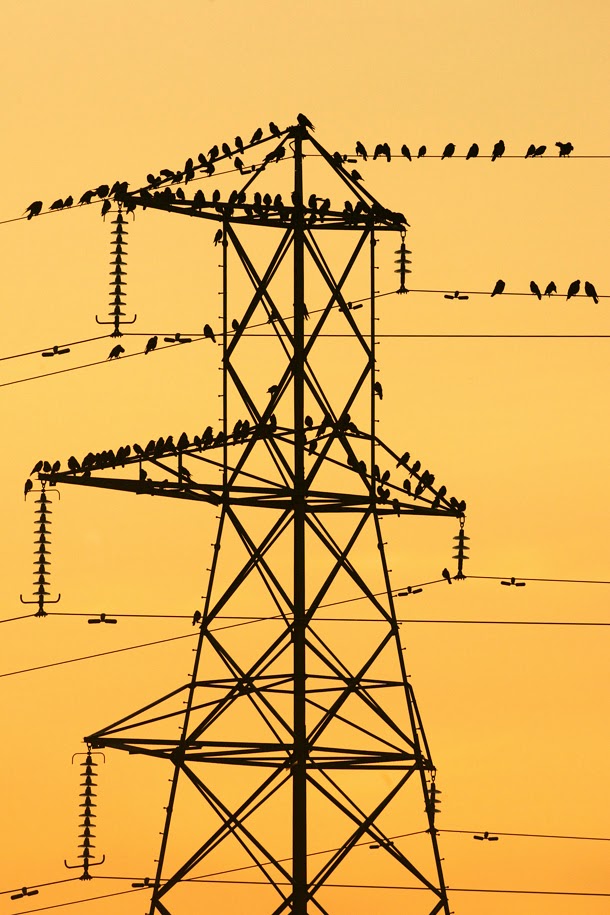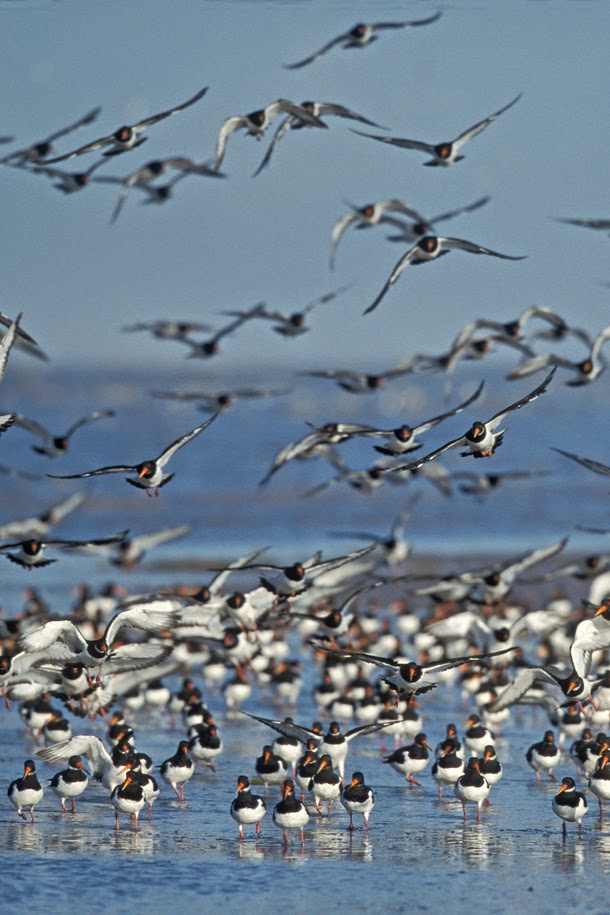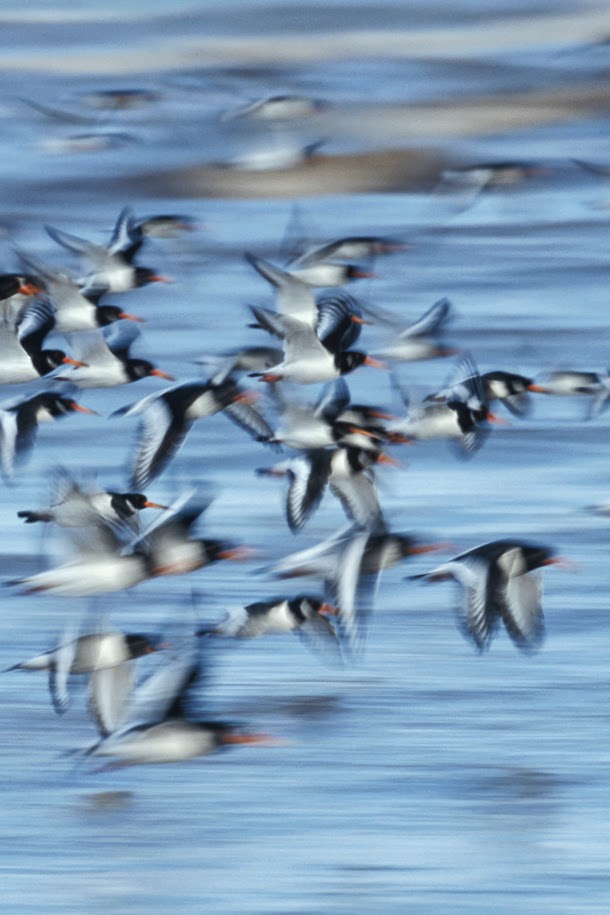You don’t need a ridiculously long lens to get beautiful pictures of birds. We explain you how to photograph flocks of birds in five ridiculously creative ways.
I then selected Spot metering, and positioned the centre AF point over the brightest part of the sky, before half-pressing the shutter release to focus, and take an exposure reading.
This gave me shutter speed of 1/500 sec. I then locked the exposure using the AE lock (*) button.
Exposing for a bright part of the sky ensured the sky was well exposed and nicely saturated, while that the birds and pylons were under-exposed (and therefore thrown into silhouette).
With the camera set up on a tripod I waited quietly as each incoming wave forced the farthest birds to take flight and join the others.
This was the picture I was after, so I focused on the group of birds at the bottom and framed the shot in anticipation of the airborne birds filling the top half of the picture.
As each group of birds flew in I took a series of shots using the high-speed continuous autofocus setting (also known as burst mode).
I then waited for the moment that some of the birds in flight came into focus to take the shot.
I set exposure in manual (M) mode, taking a reading using evaluative (average) metering from an area of beach that excluded the brighter sky.
Then by staying still and quiet, the birds remained relaxed and gradually came closer.
By positioning myself on one of the main flight paths I was able to photograph a succession of small flocks of waders as they flew.
It was a mostly cloudy day and so rather than crank up the ISO (with the resultant noise problems) to get a fast enough shutter speed to freeze the motion, I deliberately chose a much slower shutter speed to capture some blur in the oystercatchers’ wings.
The camera was set up on a tripod, which allowed me to make a smooth pan as the birds flew by, with the aim of keeping some of the birds’ heads tolerably sharp.
To focus, I selected multi-AF point selection (i.e. all to the focus points) and used AI Servo mode (also known as continuous focus or focus tracking) to track the birds.
This allowed me to focus on the birds as they approached from the left, and then take a series of shots as they came square on to the camera.
When light levels are low, go with the flow and shoot with a very slow shutter speed for lots of blurring and a more impressionistic feel
Instead I decided to capture a more creative image of the flock by setting a very slow shutter speed.
I was also handholding the camera, so I knew that nothing in the picture would be sharp, with lots of blurring of the birds’ wings, and that this would create an impressionistic representation of the flock that had a real sense of movement.
As the light levels dropped, so did the shutter speed, which resulted in varying degrees of blurring, but I found around 1/8 sec was about right for the effect I wanted.
This is one of the great spectacles in the birding world, and a fantastic opportunity for photography.
There are a number of traditional starling roosts around the India and Europe, some of which can number several million birds, but the technique works equally well for other species of bird, and potentially even bats in certain parts of the worlds.
The starlings begin to flock together about 30 minutes before sunset, so I set up my gear close to the roost site, framed the shot against the most colourful section of sky and waited for the action to unfold.
As the birds massed up, I concentrated on trying to capture the most interesting formations.
I exposed for the sky using Evaluative (Matrix) metering, which – as with the rooks in Image 1 – rendered the birds as silhouettes.
When this occurs is a matter of luck, but it’s well worth making several visits to a roost site to capture this at its best.
01.Shoot a Silhouette
Birds often gather together at dawn and dusk, which is the ideal time for creating colourful silhouettes |
| Rooks at Sunrise. Taken with: Canon 50D with 300mm f/4. Exposure: 1/500 sec at f/8, ISO200 |
How I got the shot
Having previously seen flocks of rooks gathered together on electricity pylons, I set out to try to capture a shot that put them in context with this man-made structure.
For the shot to work I needed an interesting sky, so I chose to shoot at sunrise to give myself the best chance of getting what I wanted.
To avoid disturbing the birds I used my bike as a ‘mobile hide’, which I carefully positioned so that the birds were lined up with the most colourful part of the sky behind them.
To create a simple graphic image, I decided to throw the birds and the pylon into silhouette against a well-saturated orange sky.
For the shot to work I needed an interesting sky, so I chose to shoot at sunrise to give myself the best chance of getting what I wanted.
To avoid disturbing the birds I used my bike as a ‘mobile hide’, which I carefully positioned so that the birds were lined up with the most colourful part of the sky behind them.
To create a simple graphic image, I decided to throw the birds and the pylon into silhouette against a well-saturated orange sky.
Key camera settings
I first selected the centre AF point in Single Shot focusing mode, and set an aperture of f/8 in Aperture Priority mode (Av) to ensure all of the birds would be in focus, from front to back.I then selected Spot metering, and positioned the centre AF point over the brightest part of the sky, before half-pressing the shutter release to focus, and take an exposure reading.
This gave me shutter speed of 1/500 sec. I then locked the exposure using the AE lock (*) button.
Exposing for a bright part of the sky ensured the sky was well exposed and nicely saturated, while that the birds and pylons were under-exposed (and therefore thrown into silhouette).
Field notes
Rooks gather in large numbers at winter roost sites, and will often perch on nearby telegraph wires and pylons after leaving their roost sites early in the morning.02.Photograph Wading Birds
Late autumn through to early spring is an ideal time to photograph flocks of wading birds as they gather in their tens of thousands around the coast. |
| Oystercatchers. Taken with: Canon 50D with 300mm f/4. Exposure: 1/1000 sec at f/5.6, ISO200 |
How I got the shot
As the incoming tide started to cover their feeding grounds, I knew these oystercatchers would move towards me, giving me the perfect opportunity to photograph them.With the camera set up on a tripod I waited quietly as each incoming wave forced the farthest birds to take flight and join the others.
This was the picture I was after, so I focused on the group of birds at the bottom and framed the shot in anticipation of the airborne birds filling the top half of the picture.
As each group of birds flew in I took a series of shots using the high-speed continuous autofocus setting (also known as burst mode).
Key camera settings
I autofocused on the closest birds and then switched my lens to manual focus to lock the focus, and prevent the lens hunting around for a focus point when the other birds took flight.I then waited for the moment that some of the birds in flight came into focus to take the shot.
I set exposure in manual (M) mode, taking a reading using evaluative (average) metering from an area of beach that excluded the brighter sky.
Field notes
They key to successfully shooting this wader flock was getting into position whilst the birds were some distance away, and crouching down so that my outline was not visible.Then by staying still and quiet, the birds remained relaxed and gradually came closer.
03.Capture Motion Blur
Rather than freeze the action, set a slow shutter speed and pan the camera for a more creative image that conveys movement within a flock |
| Flock of Oystercatchers. Taken with: Canon 50D with 300mm f/4. Exposure: 1/30 sec at f/8, ISO100 |
How I got the shot
Along the coast at high tide there is usually quite a lot of movement of birds, as groups fly from their feeding grounds to gather at a nearby roost site.By positioning myself on one of the main flight paths I was able to photograph a succession of small flocks of waders as they flew.
It was a mostly cloudy day and so rather than crank up the ISO (with the resultant noise problems) to get a fast enough shutter speed to freeze the motion, I deliberately chose a much slower shutter speed to capture some blur in the oystercatchers’ wings.
The camera was set up on a tripod, which allowed me to make a smooth pan as the birds flew by, with the aim of keeping some of the birds’ heads tolerably sharp.
Key settings
I set a shutter speed of 1/30 sec in Shutter Priority (Tv) mode to give the right amount of blurring.To focus, I selected multi-AF point selection (i.e. all to the focus points) and used AI Servo mode (also known as continuous focus or focus tracking) to track the birds.
Field notes
For this type of shot to work it was important that I was positioned roughly parallel to the birds’ flight path.This allowed me to focus on the birds as they approached from the left, and then take a series of shots as they came square on to the camera.
04.Become an impressionist
When light levels are low, go with the flow and shoot with a very slow shutter speed for lots of blurring and a more impressionistic feel
 |
| Starling flock at dusk. Taken with: Canon 50D with 70-200mm lens at 190mm. Exposure: 1/10 sec at f5.6, ISO 400 |
How I got the shot
On one of my visits to a starling roost the weather was poor, with a heavily overcast sky and low light. There was little point in attempting to get sharp shots of the birds, and even if I had the results would have been rather dull.Instead I decided to capture a more creative image of the flock by setting a very slow shutter speed.
I was also handholding the camera, so I knew that nothing in the picture would be sharp, with lots of blurring of the birds’ wings, and that this would create an impressionistic representation of the flock that had a real sense of movement.
Key camera settings
I used Aperture Priority (Av) mode and set this to f5.6, which gave me a slow shutter of 1/10 sec at ISO400.As the light levels dropped, so did the shutter speed, which resulted in varying degrees of blurring, but I found around 1/8 sec was about right for the effect I wanted.
Field notes
The important point for this shot is to remain flexible in your approach. If the light is not right for one type of shot then think how you can use it to your advantage to create something different.05.Go back for more
By making repeated visits to a traditional or well-used site you stand a much better chance of capturing interesting behaviour and improving your imagesHow I got the shot
During the winter months (November to February) in India, large flocks of starlings gather together each evening before going off to roost.This is one of the great spectacles in the birding world, and a fantastic opportunity for photography.
There are a number of traditional starling roosts around the India and Europe, some of which can number several million birds, but the technique works equally well for other species of bird, and potentially even bats in certain parts of the worlds.
The starlings begin to flock together about 30 minutes before sunset, so I set up my gear close to the roost site, framed the shot against the most colourful section of sky and waited for the action to unfold.
As the birds massed up, I concentrated on trying to capture the most interesting formations.
Key camera settings
By the time the starlings arrived in large numbers the light was fading quickly, so I increased the ISO setting to 800, which gave me a shutter speed of 1/500 sec at maximum aperture – just enough to arrest the movement.I exposed for the sky using Evaluative (Matrix) metering, which – as with the rooks in Image 1 – rendered the birds as silhouettes.
Field notes
Starlings form their tightest flocks when there is a bird of prey around, which was the case on the evening I took this shot.When this occurs is a matter of luck, but it’s well worth making several visits to a roost site to capture this at its best.
This is a smart blog. I mean it. You have so much knowledge about this issue, and so much passion. You also know how to make people rally behind it, obviously from the responses. Architecture Photographer in London
ReplyDeleteExactly, you're very kind of us about comment!. actor photographer
ReplyDeleteYou know your projects stand out of the herd. There is something special about them. It seems to me all of them are really brilliant! Wedding Planners
ReplyDelete